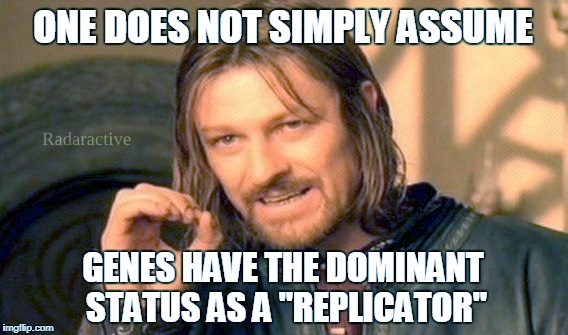One Gene to Rule them All
Back over forty years ago, the hands at the Darwin Ranch obtained copies of The Selfish Gene by C. Richard Dawkins, which became one of their sacred texts — I mean, textbooks. Dawkins made a number of assumptions upon which he built his arguments. One of these was the analogy used in the title, that somehow, genes get dominant status as "replicators", the whole purpose is to keep making copies of themselves.
Unfortunately, it wasn't until recently that some scientists actively questioned and doubted what Dawkins was presenting. Now there are squabbles in the bunkhouse, some saying that the individual is what matters, others say the group drives evolution and natural selection, and so on. None of them are willing to admit that cells, organisms, and the like have the appearance of design because (wait for it) they are designed by the Master Engineer. Dawkin's book caused problems for Darwinists, and some rethinking (with the requisite presupposition of naturalism) is in progress.
To read the rest, click on "'Selfish Gene' Metaphor Misleads Evolutionists".A recent opinion piece posted on the Chemistry World website notes that Richard Dawkins’ 1976 book The Selfish Gene deeply motivated a generation of biologists to adopt a gene-centered framework to explain why biological phenomena seem to operate for specific purposes. The book’s persuasion notwithstanding, the article notes ongoing challenges to the validity of Dawkins’ “selfish gene metaphor.” It also highlights other inconsistencies in evolutionary theory.Atheist-inclined biologists thought The Selfish Gene provides satisfactory naturalistic explanations for biology’s apparent purposeful features. Most could see that creatures have microscopic molecular machines, tissues, and organs which give every indication that they function for a purpose. Creatures also seem to endlessly engage in goal-directed behaviors. As Philip Ball at Chemistry World opines, Dawkins asserts that the reason organisms have parts appearing like they were designed for a purpose, and why they are driven to do what they do, is because they are “survival machines” whose purpose is to act solely as a vehicle to perpetuate their “selfish,” self-replicating genes. Per Dawkins, selfish genes control what traits creatures possess in their ceaseless struggle to survive.
